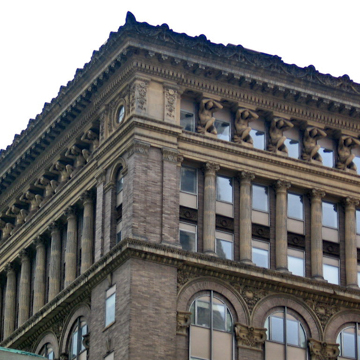By the 1890s, brothers David E. and William G. Park had brought their father's Black Diamond Steel Works (c. 1870–1890; 2949 Smallman Street with remnants from 28th to 32nd streets) to world renown in specialty steel, and they sought to diversify their investments. Their goal was to put up Pittsburgh's most imposing office block, for which they chose the busiest corner in the city, opposite the Mellon brothers' bank and the Kaufmann brothers' giant retail store. This was the fourth steel-skeleton tower in Pittsburgh, and at fifteen stories, significantly taller than the Carnegie Building of a few years before. Today, it survives as the only downtown skyscraper of the nineteenth century. New York architect George B. Post was, at the time, the preeminent designer of commercial buildings within the Beaux-Arts style. The novelty of the Park Building has always been the thirty telemones, or atlases, that bear the top cornice on their shoulders. The overall design remains an excellent material lesson in early skyscraper packaging influenced by New York City's skyscrapers (as opposed to those of Chicago), which were reluctant to sacrifice decoration to the demands of modern function and utility.
You are here
Park Building
If SAH Archipedia has been useful to you, please consider supporting it.
SAH Archipedia tells the story of the United States through its buildings, landscapes, and cities. This freely available resource empowers the public with authoritative knowledge that deepens their understanding and appreciation of the built environment. But the Society of Architectural Historians, which created SAH Archipedia with University of Virginia Press, needs your support to maintain the high-caliber research, writing, photography, cartography, editing, design, and programming that make SAH Archipedia a trusted online resource available to all who value the history of place, heritage tourism, and learning.


